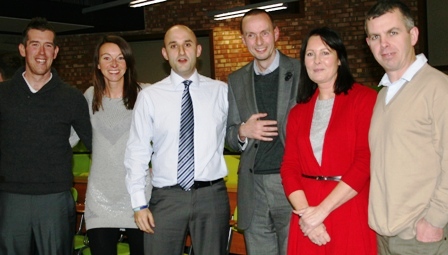
St Johns, York: home to the latest TLR Coaching Insight
The chameleon coach: exploring the pressures on modern coaches
As the tectonic plates of the sporting landscape shift and occasional volcanic eruptions alter the very ground they walk on, one of the greatest challenges modern coaches face is that of having to be all things to all people. At The Leisure Review’s Coaching Insight in York a room full of developed and developing coaches explored the evolving panorama.

St Johns, York: home to the latest TLR Coaching Insight
How, for example, would Rob Brierley, the performance manager for the Scottish Rugby Union’s (SRU) “exiles” programme, engage young people who may have experienced high-level performance sport but could never have coached in that context? His answer, familiar to anyone placed in front of a challenging audience, was to ask the people in the room to come up with the answers. Invited to come up with ten words they associated with the phrase “developing performance in sport”, groups of coaches went at it with a will and produced a variety of interpretations. This was exactly what Brierley had expected as he then strongly made the argument that words like ’performance’ and ‘academy’ are bandied about in so many contexts as to be rendered almost meaningless.
Given that his job is to manage performance, he had his own and his organisation’s definition; and, with passing reference to the sports development pyramid and the UK Sport definition of performance, he offered an insight into how the SRU goes about not only developing obviously effective age-group rugby players but also those who might be “developing late or coming in from left field”. While he acknowledged that it was necessary to “identify some who are good now”, he also needed to spot those players “who will be good later”. Brierley then looked in detail at some of the strategies the SRU uses to develop talented players and spoke about their move to a more individual approach in future.
He then produced one of the light bulb moments which characterise the Coaching Insight series. The Youth Sport Trust has a slide which they call Team You. Variations of it can be seen in sports from ice skating to cricket and in all these variations the basic configuration is the same: the athlete is placed at the centre of a circle and around the hub of the circle sit nutritionists and psychologists, pals and parents, coaches and teachers. Depending on the level of the performer and the sport, these significant others vary but the essential diagram remains the same; everybody belongs to Team You and everyone supports “you”. In the SRU version the performer is moved from the centre to the hub along with everybody else and has to take responsibility as “part of the bigger picture”. This is a paradigm shift for performance coaching and a real eye opener for those who look at Wayne Rooney’s various bad behaviours and wonder how a young man from his background could have such a stilted perspective on life.
Young men and women, their perspectives and behaviours underpin and determine the progress of Active Fusion, a school sports partnership (SSP) from Doncaster. Partnership development manager Lindsy Gray and her number two Andy Lockwood have had a tough year with “massive change, both political and organisational” making the months since Michael Gove slashed the SSP network’s funding more than a little challenging. Gray was at pains to make clear that “SSPs are still out there and working alongside local delivery agencies” but that national coverage is sporadic and littered “with lots of delivery errors”.
“Schools have all the power now,” she explained, as they “no longer have government targets on participation” and headteachers “do not have to buy sport”. In this environment Gray and people like her have developed new approaches to physical activity and how it is delivered, approaches characterised in Active Fusion’s case by core values which put “the performer at the centre of our organisation”. One example she gave is that when 22 places are available on an after-school club or lunchtime coaching session “it’s the first 22 through the door” that get the benefit, not the most talented or the most sporty.
Andy Lockwood’s position in the partnership is shored up by the minimal funding which Secretary Gove has handed down to ensure that school sport regains the sunny uplands of “healthy competition”. From what Lockwood said about being “not a fan of the UKCC” and the coaches it produces and about “marketing alternative sport” to non-sporty kids Mr Gove might find his Schools Olympics even more a box-ticking exercise than his minions designed it to be. What is more certain is that advocates for the Active Fusion style of delivery, where coaches focus on the performer not the activity, will continue to make converts (the younger element of the York audience were clearly excited by Gray and Lockwood’s presentation) while “the man with the bag of balls” finds his offer less and less sustainable in the modern schools landscape.
The response of a mixed audience to a variety of speakers within a common theme is both a challenge and a reward to a seminar organiser. Following a break to allow people to mingle, Helen Whitrod Brown of Leeds Metropolitan University gave an overview of her department’s collaboration with Morrisons, the supermarket chain, which polarised this particular audience with perhaps the more established coaches keen to explore what Carnegie had learned from the process and any implications there might be in that for their own practice. Others seemed less convinced that an intervention which has revolutionised a traditionally run mercantile giant using little more than standard coaching techniques might impact on them at some point.
For Whitrod Brown the “cross-domain transfer of sports coaching skills into a business context” is both the subject of her doctoral thesis and proof that if “everybody can achieve excellence” – which, after all, is the message of long-term athlete development – then “coaching is the tool to make that happen”. Morrisons, however, is not an entity with 10,000 hours to deploy and have sought to change their culture far more expeditiously. Hundreds of managers have been trained in new techniques and new behaviours aimed at helping frontline staff improve customer care. In stark contrast to even the most dedicated athlete, every day is a competition day for grocers and it is Morrisons assertion that allying their great values, people and commitment to great coaching will give the great results they require. It is a simple equation but the amazement comes in the scope of the project and the staggering resource commitment made by the company.
If a business working with sports coaching experts seems to be ahead of the wave the final speaker, Professor Andy Smith of the host institution, made it seem short term by addressing the futurology of sport. For many of the audience this approach, looking far into the future to draw inferences for the present, was a novel experience but not nearly as surprising as the man delivering it. Smith is a nutty professor. He waves his arms, talks 19 to the dozen and scatters allusions like confetti as he breezes through his subject matter. He is amusing, challenging and reassuring. If people like this are bringing on the next generation of coaches and sports scientists we may just be alright.
The first challenge Smith laid down, and perhaps the most significant, was to accept that the future of sport lay in the hands of the people in the room; we can create our own futurology. His view that “sport hasn’t changed enough” and that “it is stuck in models of professional practice” was reason enough to seek change but Smith then went on to show where the cosy assumptions of today’s system builders were about to be challenged.
Society has changed and sport will change is Smith’s thesis. He has agreed to expound it in an article in the fiftieth edition of The Leisure Review [March 2012] but as a taster, not a spoiler, he foresees PlayStation coaches, combined Olympics and Paralympics, and a situation where “modern Elizabethans will develop rules for sport which are better than those developed by the Victorians”.
It was entirely appropriate that a seminar characterised by variety should end with a scattergun-wielding sports philosopher and equally appropriate that the York seminar should conclude the 2011 Coaching Insight programme with the challenge to everyone in coaching, particularly those new to the trade, to shape its future.
The Leisure Review, February 2012
© Copyright of all material on this site is retained by The Leisure Review or the individual contributors where stated. Contact The Leisure Review for details.
Download a pdf version of this article for printing
